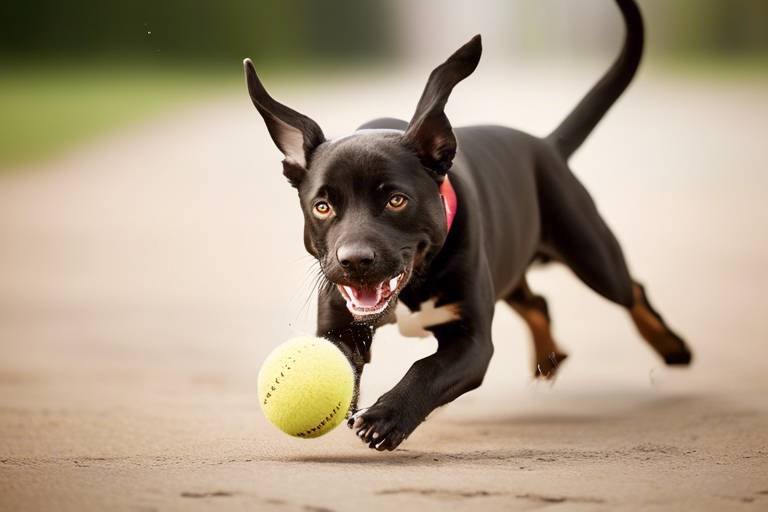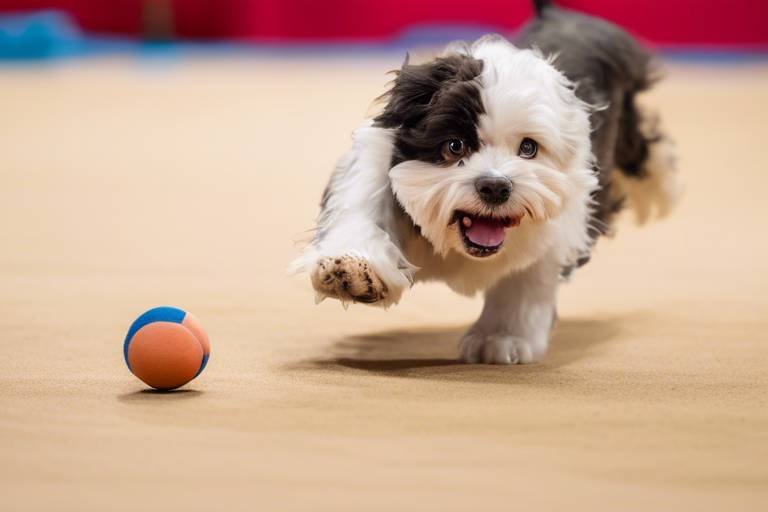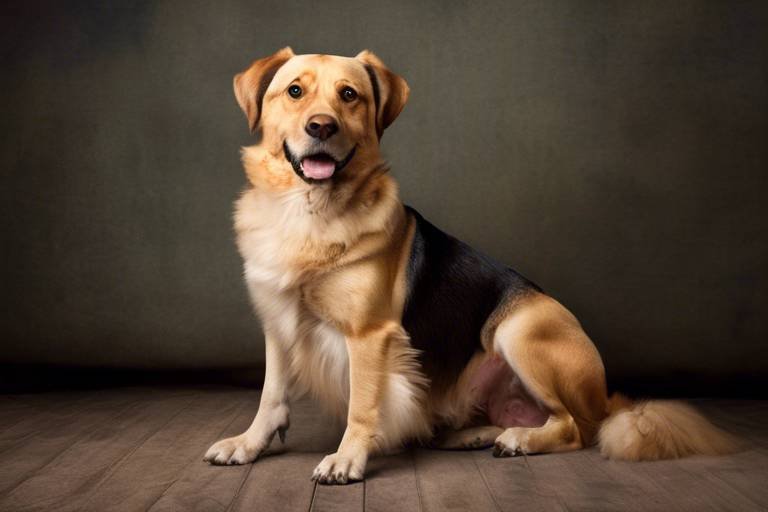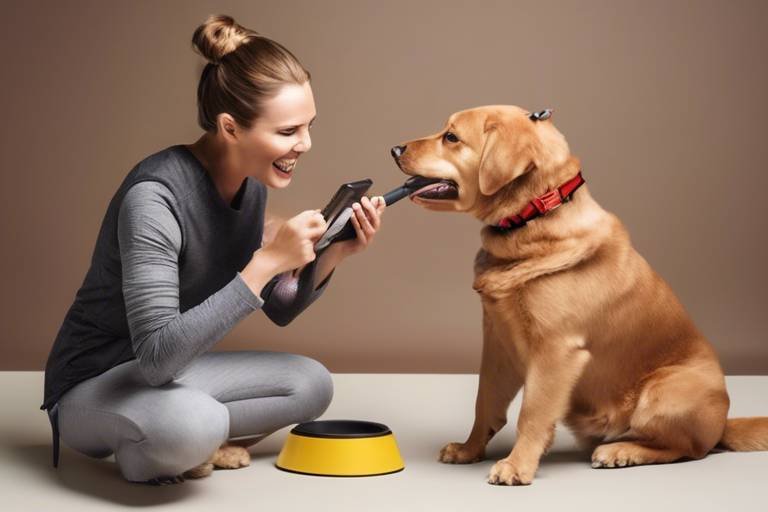How to Address Aggressive Behavior in Dogs
Dealing with aggressive behavior in dogs can feel like navigating a minefield. One moment, your furry friend is happily wagging their tail, and the next, they’re barking and lunging at something—or someone. Understanding how to address this behavior is crucial for maintaining a safe environment for both pets and their owners. In this article, we will explore effective strategies to manage and correct aggressive behavior, ensuring that your relationship with your dog is built on trust and respect.
Recognizing the different types of aggression in dogs is crucial for effective management. Aggression can stem from various causes, including fear, territorial instincts, and even medical issues. By identifying the signs early, you can take proactive steps to prevent escalation. For instance, a dog that growls when approached while eating may be displaying resource guarding behavior, which can be addressed with the right techniques.
Understanding what triggers aggression in dogs can help owners prevent incidents before they happen. Common triggers include:
- Fear: A dog that feels threatened may react aggressively.
- Territoriality: Dogs often become protective of their home or yard.
- Resource Guarding: This occurs when dogs feel the need to protect their food, toys, or even their owners.
By recognizing these triggers, you can develop better management strategies to keep your dog—and those around them—safe.
Fear-based aggression occurs when a dog feels threatened or anxious. It’s essential to understand that this type of aggression is not a sign of a bad dog; rather, it reflects a lack of confidence. Identifying fearful behaviors, such as cowering or tucked tails, is the first step in helping your dog feel more secure in their environment. For instance, if your dog barks at strangers, they might be feeling scared rather than aggressive. Understanding this distinction can help you respond appropriately.
Recognizing signs of fear can aid in addressing aggression effectively. Some common indicators include:
- Body language: Ears back, tail tucked, and avoiding eye contact.
- Vocalizations: Whining or growling when approached.
- Physical reactions: Trembling or trying to escape.
By observing these behaviors, you can intervene before aggression escalates.
Desensitization can be a powerful tool in reducing fear-related aggression. This technique involves gradually exposing your dog to their triggers in a controlled manner, allowing them to build confidence over time. For example, if your dog is afraid of loud noises, start by playing recordings of those sounds at a low volume and rewarding them for staying calm. Slowly increase the volume as your dog becomes more comfortable, reinforcing their positive behavior with treats and praise.
Resource guarding occurs when dogs protect their possessions, such as food or toys. Understanding this behavior is crucial for effective management. Dogs may growl, snap, or even bite when they feel their resources are threatened. It’s important to approach this issue with empathy and patience. Training techniques, such as teaching your dog to "drop it" or "leave it," can help mitigate resource guarding behaviors and foster a sense of security.
Training is essential for managing aggression. It’s not just about correcting bad behavior; it’s about building a solid foundation of trust and communication between you and your dog. Various training methods can be employed, including positive reinforcement and obedience training, to help modify aggressive behaviors. Consistency and patience are key, as changing behavior takes time.
Positive reinforcement encourages desired behaviors by rewarding your dog for good actions. This approach can effectively reduce aggression while building trust between you and your dog. For instance, if your dog remains calm when a stranger approaches, offer them a treat and praise. Over time, they will associate positive experiences with previously stressful situations, leading to a more relaxed demeanor.
Sometimes, professional intervention is necessary. If your dog displays severe aggression, it’s crucial to consult a certified dog trainer or behaviorist. These professionals can assess your dog's behavior and create a tailored approach to meet their specific needs. Remember, seeking help is a sign of responsibility, not failure, and can lead to a happier, healthier relationship with your furry friend.
- What should I do if my dog shows aggression towards other dogs?
Start by keeping a safe distance from other dogs and gradually desensitize your dog to their presence. Training and socialization can also help.
- Can aggression in dogs be cured?
While some dogs may not completely lose aggressive tendencies, with proper training and management, many can learn to behave more appropriately.
- Is it safe to adopt a dog with a history of aggression?
It depends on the dog and your experience. Assess their behavior and consult with professionals to determine if they are a good fit for your home.
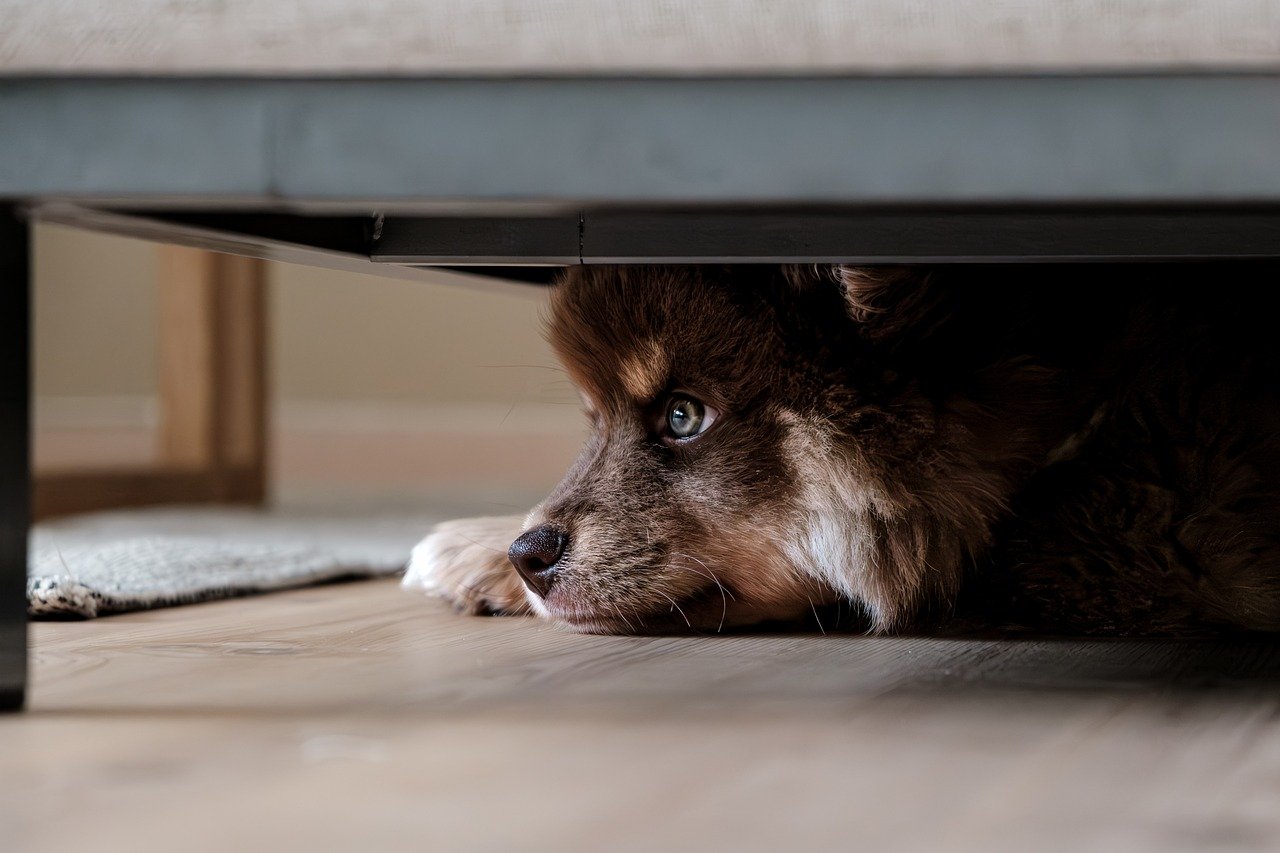
Understanding Aggression in Dogs
This article explores effective strategies for managing and correcting aggressive behavior in dogs, ensuring a safer environment for both pets and their owners while promoting positive interactions.
When it comes to our furry friends, understanding aggression is not just important; it's essential. Aggression in dogs can manifest in various forms, and recognizing these forms is crucial for effective management. Whether your dog is barking at strangers, growling over a toy, or showing teeth when approached, these behaviors can stem from different underlying causes. By identifying the root of the aggression, you can take the necessary steps to address it.
There are several types of aggression to be aware of, including fear-based aggression, territorial aggression, and resource guarding. Each type has its own triggers and signs, which can help owners intervene before situations escalate. Understanding the context in which your dog displays aggressive behavior is like having a map—it guides you through the maze of canine emotions and helps you navigate toward a solution.
For instance, fear-based aggression often arises when a dog feels cornered or threatened. Imagine being in a dark alley with someone looming over you; your instinct might be to lash out or defend yourself. Similarly, dogs may react aggressively when they feel scared. On the other hand, territorial aggression can surface when a dog perceives intruders in their space, while resource guarding occurs when dogs feel the need to protect their food, toys, or even their humans.
Recognizing these behaviors early can prevent them from escalating into dangerous situations. Here are some common signs of aggression to watch for:
- Growling: A warning sign that should never be ignored.
- Baring Teeth: A clear indication that a dog feels threatened.
- Stiff Body Language: A tense posture can suggest a dog is preparing to act aggressively.
- Snapping: A dog may snap at perceived threats, which can be alarming.
By understanding the different types of aggression and their signs, dog owners can take proactive measures to create a safer environment. This knowledge not only protects others but also helps the dog feel more secure and understood. After all, a well-informed owner is a dog’s best ally in overcoming aggression.
Understanding what triggers aggression in dogs can help owners prevent incidents. This section covers common triggers such as fear, territoriality, and resource guarding, enabling better management strategies.
Fear-based aggression occurs when a dog feels threatened. This subsection explains how to identify fearful behaviors and techniques to help dogs feel more secure in their environment.
Recognizing signs of fear can aid in addressing aggression. This section discusses body language and behaviors indicating fear, allowing owners to intervene appropriately.
Desensitization can reduce fear-related aggression. This subsection outlines methods for gradually exposing dogs to their triggers in a controlled manner, promoting a more confident demeanor.
Resource guarding occurs when dogs protect their possessions. This section highlights the importance of understanding this behavior and strategies to mitigate it effectively.
Training is essential for managing aggression. This section discusses various training methods, including positive reinforcement and obedience training, to help modify aggressive behaviors.
Positive reinforcement encourages desired behaviors. This subsection explains how rewarding good behavior can effectively reduce aggression and build trust between dogs and their owners.
Sometimes, professional intervention is necessary. This section emphasizes the importance of consulting a certified dog trainer or behaviorist for severe aggression cases, ensuring a tailored approach to the dog’s needs.
Q: What is the most common cause of aggression in dogs?
A: Fear is often the most common cause of aggression. Many dogs react aggressively when they feel threatened or cornered.
Q: Can aggressive behavior be trained out of a dog?
A: Yes, with consistent training and positive reinforcement, many dogs can learn to manage their aggressive behaviors effectively.
Q: When should I seek professional help for my dog's aggression?
A: If your dog's aggression escalates or poses a danger to people or other pets, it's crucial to consult a certified dog trainer or behaviorist.
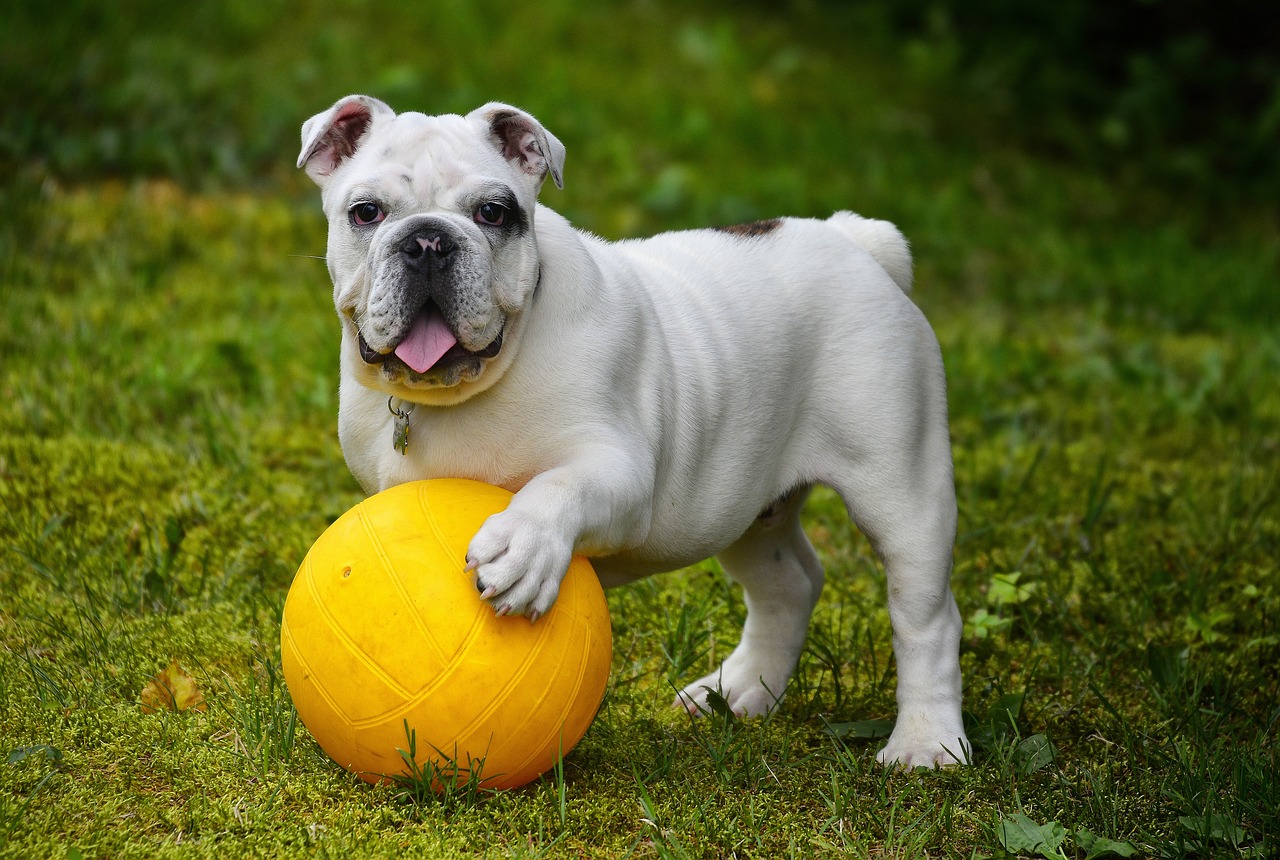
Identifying Triggers
Understanding what triggers aggression in dogs is a vital step in ensuring a safe and harmonious relationship between pets and their owners. Just like humans, dogs have their own unique personalities and sensitivities, which means that what might provoke one dog could be completely harmless to another. By identifying these triggers, you can take proactive measures to prevent aggressive incidents before they occur.
Common triggers for aggression can often be categorized into a few key areas. These include:
- Fear: A dog that feels threatened may react aggressively as a means of self-defense.
- Territoriality: Dogs are naturally protective of their space, and they may exhibit aggression towards perceived intruders.
- Resource Guarding: This occurs when a dog feels the need to protect their food, toys, or even their human companions from others.
By being aware of these triggers, you can begin to observe your dog's behavior in various situations. For instance, does your dog growl or bark when someone approaches their food bowl? Or do they become tense and defensive when a stranger enters your home? These signs can be indicative of underlying issues that need to be addressed.
It's also important to consider the context in which aggressive behavior occurs. For example, a dog that is normally friendly may act aggressively during a stressful event, such as a thunderstorm or a visit to the vet. Understanding these contextual triggers can help you manage your dog's behavior more effectively. Keeping a journal of your dog's reactions in different situations can be a useful tool in identifying patterns and triggers.
In some cases, aggression can stem from a lack of socialization. Dogs that haven’t been exposed to various environments, people, and other animals may react aggressively out of uncertainty or fear. This is why early socialization is crucial for puppies. If you have an older dog that exhibits aggressive tendencies, it might be beneficial to gradually introduce them to new experiences in a controlled manner.
Ultimately, identifying triggers is about observing and understanding your dog. Each dog is unique, and what triggers one may not trigger another. By paying close attention to your dog's body language and reactions, you can create a safer environment for both of you. Remember, the goal is to foster a sense of security and trust, allowing your dog to feel comfortable and less likely to react aggressively.
In summary, recognizing and understanding the triggers of aggression in dogs is a crucial step towards effective management. By taking the time to observe your dog's behavior and identifying specific triggers, you can help mitigate aggressive responses and promote a more peaceful coexistence.
Fear-Based Aggression
Fear-based aggression is a complex behavior that can be both alarming and challenging for dog owners. It typically arises when a dog feels threatened or insecure, leading them to react defensively. Imagine your dog as a tiny fortress; when they perceive danger, their instinct is to protect their territory. This kind of aggression can manifest in various forms, from growling and barking to snapping or even biting. Understanding this behavior is crucial for any pet owner, as it not only affects the dog's well-being but also the safety of everyone around them.
To effectively address fear-based aggression, it's essential to first identify the signs that indicate your dog is feeling scared or threatened. Dogs communicate through body language, and being attuned to these signals can help you intervene before a situation escalates. For example, a dog may exhibit signs such as:
- Flattened ears
- Tucked tail
- Avoiding eye contact
- Backing away or cowering
- Growling or showing teeth
Recognizing these signs is akin to reading a book; the more you understand your dog's emotions, the better equipped you'll be to respond appropriately. If you notice your dog displaying these behaviors, it’s crucial to take a step back and assess the situation. Are they in an unfamiliar environment? Are there loud noises or other animals that might be causing distress? Identifying the root cause of their fear is the first step towards helping them feel more secure.
One effective method for helping dogs overcome fear-based aggression is through desensitization techniques. This approach involves gradually exposing your dog to the source of their fear in a controlled manner, allowing them to build confidence over time. Think of it as teaching a child to swim; you wouldn’t just throw them into the deep end. Instead, you’d start in the shallow end, allowing them to acclimate to the water. Similarly, with dogs, you can begin by introducing them to less intimidating versions of their triggers. For instance, if your dog is fearful of strangers, start by having a calm friend approach at a distance where your dog feels safe.
Throughout this process, it’s important to remain patient and supportive. Use positive reinforcement to reward your dog for calm behavior when they encounter their fears. This could be in the form of treats, praise, or playtime. Over time, as your dog learns that these situations aren’t as threatening as they once believed, their confidence will grow, and their aggressive responses may diminish.
In summary, fear-based aggression in dogs is a serious concern that requires careful attention and understanding. By recognizing the signs of fear, identifying triggers, and employing desensitization techniques, you can help your furry friend navigate their fears and foster a more peaceful coexistence. Remember, it's a journey that takes time, but with love and patience, you can guide your dog towards a more confident and less fearful life.
Q1: Can fear-based aggression be cured?
A1: While it may not be completely "cured," fear-based aggression can be significantly managed through training and behavior modification techniques.
Q2: How long does it take to see improvements?
A2: The timeline varies depending on the individual dog and the severity of their fear. Consistent training and patience are key.
Q3: Should I punish my dog for aggressive behavior?
A3: No, punishment can exacerbate fear and aggression. Focus on positive reinforcement instead.
Q4: When should I seek professional help?
A4: If your dog's aggression is severe or if you're unsure how to proceed, consulting a certified dog trainer or behaviorist is recommended.
Signs of Fear in Dogs
Understanding the signs of fear in dogs is crucial for any pet owner who wants to foster a safe and loving environment. Just like us, dogs express their feelings through body language and behavior. When a dog is afraid, it may not always bark or growl; instead, it might exhibit subtle signs that indicate distress. Recognizing these signs early on can help you address the underlying issues before they escalate into aggressive behavior.
One of the most common signs of fear is cowering. When a dog feels threatened, it may lower its body, tuck its tail between its legs, and avoid eye contact. This posture is a clear indication that the dog is feeling vulnerable. Additionally, you might notice your dog trembling or shaking, which can be a physical manifestation of fear. These behaviors are akin to a person shrinking back in a corner when faced with a daunting situation.
Another telling sign is the dog's vocalization. While barking can sometimes be a sign of excitement or alertness, a dog that is fearful may produce high-pitched whines or growls. This vocalization is often a plea for help or a warning to others to stay away. Pay close attention to the tone and pitch; a dog in fear may sound different than one that is simply trying to get your attention.
Furthermore, dogs may engage in avoidance behaviors when they are scared. This can include turning away, hiding, or trying to escape the situation altogether. For example, if you notice your dog trying to crawl under furniture or retreating to a safe spot in the house, it’s a clear signal that something is causing them distress. In these moments, it’s essential to be patient and allow your dog to feel secure, rather than forcing them to confront their fears.
To help you better understand the signs of fear in dogs, here’s a quick reference table:
| Sign of Fear | Description |
|---|---|
| Cowering | Lowering body, tucking tail, avoiding eye contact |
| Trembling | Shaking or shivering, indicating distress |
| Vocalization | High-pitched whines or growls, signaling fear |
| Avoidance | Trying to escape or hide from the situation |
By recognizing these signs, you can take proactive steps to help your dog feel more secure. It’s important to remember that fear is a natural response, and with the right approach, you can help your furry friend build confidence. Whether it’s through desensitization techniques or creating a safe space at home, addressing fear early on can prevent it from manifesting into more serious behavioral issues, including aggression.
- What should I do if I notice my dog is fearful? It's important to create a safe environment for your dog. Try to identify the trigger and remove it if possible. Gradually expose your dog to the fear-inducing situation in a controlled manner.
- Can fear lead to aggression? Yes, fear can often lead to aggressive behavior if not addressed. A scared dog may feel the need to defend itself, resulting in growling, barking, or even biting.
- Should I punish my dog for being fearful? No, punishing a fearful dog can exacerbate the problem. Instead, focus on positive reinforcement and creating a supportive environment.
Desensitization Techniques
Desensitization is a powerful method for helping dogs overcome their fears and reduce aggression triggered by specific stimuli. Imagine your dog as a balloon filled with tension; with each exposure to a fear-inducing situation, that balloon inflates a little more. The goal of desensitization is to slowly and gently release that pressure, allowing your dog to feel more relaxed and secure. This technique involves gradually exposing your dog to the source of their fear in a controlled manner, ensuring that the experience remains positive and non-threatening.
To start, it’s essential to identify the specific triggers that cause your dog to react aggressively. This could be anything from loud noises, other dogs, or even certain types of people. Once you have pinpointed these triggers, you can begin the desensitization process. The key is to introduce these triggers at a distance or intensity that does not provoke a fearful response. For example, if your dog is afraid of other dogs, you might start by observing another dog from a safe distance where your dog feels comfortable.
As your dog becomes accustomed to the presence of the trigger without reacting negatively, you can gradually decrease the distance or increase the intensity of the exposure. It’s vital to pair these encounters with positive reinforcement, such as treats or praise, to create a positive association with the previously feared object or situation. This process can take time and patience, but the results are well worth the effort. Below is a simple table outlining the steps for a successful desensitization process:
| Step | Description |
|---|---|
| 1 | Identify the trigger causing fear or aggression. |
| 2 | Begin exposure to the trigger at a safe distance. |
| 3 | Use positive reinforcement to reward calm behavior. |
| 4 | Gradually decrease the distance or increase the intensity. |
| 5 | Continue to reward and monitor your dog’s reactions. |
It’s important to remember that desensitization is not a one-time fix; it requires consistency and ongoing practice. Each dog is unique, so what works for one may not work for another. Be patient and allow your dog to progress at their own pace. If you notice your dog becoming overly stressed or agitated, it’s crucial to take a step back and give them space to breathe. Sometimes, seeking the advice of a professional dog trainer or behaviorist can provide additional support and guidance tailored to your dog's specific needs.
Ultimately, desensitization can transform your dog's relationship with their fears, leading to a more peaceful coexistence in your home and community. By fostering a positive environment and using these techniques consistently, you can help your dog navigate their world with confidence and ease.
- How long does desensitization take? The duration varies depending on the dog and the severity of their fear. Some dogs may show improvement in a few sessions, while others may take weeks or months.
- Can I do desensitization training on my own? Yes, many owners successfully implement desensitization techniques at home. However, if you feel overwhelmed, consider seeking professional help.
- What if my dog reacts aggressively during training? If your dog shows signs of aggression, it’s best to stop the session and reassess the distance or intensity of the trigger. Always prioritize your dog's comfort and safety.
Resource Guarding
Resource guarding is a behavior exhibited by dogs when they feel the need to protect their possessions, which can include food, toys, or even their resting places. It’s a natural instinct that stems from their ancestral roots, where survival often depended on safeguarding valuable resources. However, this instinct can lead to aggressive behaviors that pose risks to both the dog and its human companions. Understanding this behavior is crucial for pet owners, as it allows them to implement effective management strategies that promote a harmonious living environment.
When a dog displays resource guarding, it may exhibit a range of behaviors, from subtle signs like stiffening of the body or a low growl to more overt actions such as snapping or biting. Recognizing these signs early can make a significant difference in addressing the issue. For instance, if your dog growls when you approach its food bowl, it’s crucial to take that seriously rather than dismissing it as a simple quirk. Ignoring these signals can escalate the behavior, leading to potentially dangerous situations.
To effectively manage resource guarding, owners can take several proactive steps:
- Understand the Triggers: Pay attention to what items your dog is guarding. Is it their food bowl, a favorite toy, or a specific resting spot? Identifying these triggers is the first step in addressing the behavior.
- Gradual Desensitization: Slowly introduce your dog to the presence of people or other pets around its resources. Start from a distance and gradually decrease that distance as your dog becomes more comfortable.
- Trade-Up Technique: Teach your dog that giving up a resource can lead to something even better. For example, if your dog is guarding a toy, offer a high-value treat in exchange for the toy. This helps them associate giving up their resource with positive outcomes.
Additionally, creating a safe space for your dog where they can enjoy their resources without feeling threatened is essential. This might involve having a designated area where they can eat or play with their toys without disturbances. By fostering a sense of security, you can help reduce their need to guard these items.
Moreover, it’s important to remember that resource guarding can sometimes be exacerbated by underlying issues such as anxiety or a history of neglect. Therefore, if you notice persistent guarding behaviors that escalate into aggression, it may be time to consult a professional. A certified dog trainer or behaviorist can provide tailored strategies to address your dog's specific needs, ensuring a safer and more enjoyable environment for everyone involved.
In summary, while resource guarding can be a challenging behavior to manage, understanding its roots and implementing effective strategies can lead to a more peaceful coexistence. By being proactive and patient, you can help your dog feel secure and diminish their need to guard, making your home a happier place for both of you.
Q: What should I do if my dog bites while resource guarding?
A: If your dog bites while resource guarding, it’s crucial to seek professional help immediately. A certified trainer can assess the situation and provide guidance tailored to your dog's behavior.
Q: Can resource guarding be completely eliminated?
A: While it may not be possible to completely eliminate resource guarding, with consistent training and management strategies, it can be significantly reduced.
Q: Is resource guarding common in all dog breeds?
A: Resource guarding can occur in any breed, but some breeds may be more prone to it due to their genetic predispositions. Understanding your dog's background can help in managing this behavior.

Training for Aggressive Dogs
Training is absolutely essential when it comes to managing aggression in dogs. Just like humans, dogs can benefit immensely from learning how to express their feelings in a healthy way. Aggression often stems from fear, anxiety, or a lack of proper socialization, and addressing these issues through effective training can lead to a happier and more harmonious relationship between you and your furry friend. Think of training as building a bridge of communication between you and your dog, allowing you both to understand each other better.
One of the most effective methods for training aggressive dogs is through positive reinforcement. This approach focuses on rewarding desirable behaviors instead of punishing undesirable ones. For example, if your dog sits calmly when a stranger approaches, rewarding them with treats or praise reinforces that calm behavior. Over time, your dog learns that good things happen when they behave appropriately, which can significantly reduce aggressive tendencies. It's like teaching a child that sharing toys leads to more playtime with friends—who wouldn't want to encourage that?
Additionally, incorporating obedience training can be a game changer. Basic commands like “sit,” “stay,” and “leave it” not only provide your dog with structure but also help you manage their behavior in potentially aggressive situations. Imagine being at a park and your dog starts to bark at another dog. If you’ve trained them to respond to commands, you can redirect their focus and prevent escalation. It’s all about having that toolbox ready to handle various scenarios.
However, training an aggressive dog is not a one-size-fits-all approach. Every dog is unique, and what works for one may not work for another. Therefore, it’s crucial to observe your dog’s specific triggers and behaviors. For example, if your dog shows aggression towards other dogs but is fine with people, your training methods should be tailored accordingly. This may involve controlled exposure to other dogs in a safe environment, gradually increasing their comfort level. Think of it as helping them navigate a maze; you want to guide them through without overwhelming them.
In some cases, seeking professional help may be necessary. A certified dog trainer or animal behaviorist can provide tailored strategies and insights that you might not have considered. They can assess your dog’s behavior in real-time and offer solutions that are specific to your dog’s needs. This is especially important for severe aggression cases, where the stakes are higher, and safety is a priority. Remember, there’s no shame in asking for help—just like we consult experts for our own challenges, our pets deserve the same level of care.
Ultimately, the goal of training is to create a safe and enjoyable environment for both you and your dog. With patience, consistency, and the right techniques, you can help your dog overcome their aggressive tendencies and flourish into a well-adjusted companion. So, grab those treats, roll up your sleeves, and get ready to embark on a rewarding journey of training and bonding with your four-legged friend!
- How long does it take to train an aggressive dog? Training duration varies based on the dog's behavior, age, and the owner's consistency. Some dogs may show improvement in weeks, while others may need months of dedicated training.
- Can all aggressive behaviors be corrected? While many aggressive behaviors can be managed or reduced, some cases may require ongoing management rather than complete correction, especially if they stem from deep-seated fears or traumas.
- Is it safe to train an aggressive dog at home? Yes, but it’s essential to understand your dog’s triggers and ensure safety for both you and your pet. If aggression is severe, consulting a professional is advisable.
Positive Reinforcement Techniques
When it comes to managing aggressive behavior in dogs, positive reinforcement stands out as one of the most effective methods. This approach focuses on rewarding desired behaviors rather than punishing undesirable ones. Imagine training your dog like a game: when they do something right, they get a treat or praise, which makes them want to repeat that behavior. It's all about building a strong bond and trust between you and your furry friend!
One of the first steps in implementing positive reinforcement is to identify the specific behaviors you want to encourage. For instance, if your dog tends to growl when they see another dog, you can start by rewarding them for remaining calm. This could involve using treats, toys, or even verbal praise. The key is to make sure the reward is something your dog truly values. Just like us, dogs are more likely to repeat actions that lead to something they enjoy!
Here’s a simple table to illustrate how positive reinforcement can be applied:
| Behavior | Positive Reinforcement |
|---|---|
| Sitting calmly when another dog approaches | Treats and verbal praise |
| Walking on a leash without pulling | Playtime or favorite toy |
| Responding to commands | Affection and petting |
Another essential aspect of positive reinforcement is timing. You need to reward your dog immediately after they display the desired behavior. This helps them make the connection between their action and the reward. For example, if your dog sits on command and you wait too long to give them a treat, they might not understand why they’re being rewarded. Quick, consistent rewards are crucial!
As you begin to see progress, you can gradually increase the difficulty of the tasks. Start with simple commands and work your way up to more complex behaviors. This gradual increase in expectations helps keep your dog engaged and motivated. Just like climbing a mountain, it’s best to take one step at a time!
Moreover, it’s vital to remain patient and consistent throughout this process. Dogs, much like humans, can have off days. If your dog doesn’t respond positively right away, don’t get discouraged. Instead, reassess your approach and continue to encourage them with love and positive reinforcement. Remember, patience is key in any training regimen.
Lastly, incorporating socialization into your training can also be beneficial. Exposing your dog to various environments, people, and other dogs in a controlled manner can help reduce fear and anxiety, which are often the underlying causes of aggression. Pair these experiences with positive reinforcement to create a more confident and well-adjusted dog.
- What is positive reinforcement? Positive reinforcement is a training method that rewards desired behaviors to encourage their repetition.
- How long does it take to see results? The time frame varies by dog and situation; however, with consistency, many owners start seeing improvements within a few weeks.
- Can I use positive reinforcement with aggressive dogs? Yes, this method is particularly effective for aggressive dogs, as it focuses on building trust and reducing fear.
- What if my dog doesn't respond to treats? If your dog isn’t motivated by treats, try using toys, praise, or playtime as rewards.
Seeking Professional Help
When it comes to managing aggressive behavior in dogs, sometimes the best course of action is to seek professional help. Just like humans, dogs can have complex emotional and behavioral issues that may require the expertise of a trained professional. If your dog's aggression is severe or if you've tried various methods without success, don't hesitate to reach out to a certified dog trainer or a veterinary behaviorist. These professionals are equipped with the knowledge and skills to address your dog's specific needs.
Professional trainers and behaviorists can offer tailored solutions that take into account your dog's unique personality and history. They often employ a combination of techniques, including behavior modification strategies and positive reinforcement, to help your dog learn to cope with triggers and reduce aggressive tendencies. Moreover, they can guide you on how to foster a better relationship with your pet, emphasizing trust and communication.
It's important to choose a professional who uses humane training methods. Avoid trainers who rely on punishment or fear-based techniques, as these can exacerbate aggression and lead to further behavioral issues. Instead, look for someone who emphasizes positive reinforcement and has a solid understanding of canine behavior. Here are a few tips to help you find the right professional:
- Check qualifications: Look for trainers who are certified by recognized organizations such as the Association of Professional Dog Trainers (APDT).
- Read reviews: Look for testimonials or ask for references from other pet owners.
- Observe a session: If possible, observe a training session to see how the trainer interacts with dogs and their owners.
Once you've found a suitable professional, be prepared to discuss your dog's history and the specific issues you're facing. This information will help them create a customized plan that addresses your dog's aggression effectively. Remember, patience and consistency are key. Behavioral modification takes time, and it's essential to remain committed to the process.
In conclusion, seeking professional help can be a game-changer in managing your dog's aggression. With the right guidance, you can create a safer environment for both your dog and your family, paving the way for a more harmonious life together.
Q: How do I know if my dog's aggression is serious enough to seek professional help?
A: If your dog displays aggressive behavior that poses a risk to others, such as biting or lunging, or if you feel overwhelmed and unsure of how to manage the behavior, it’s time to consult a professional.
Q: What should I expect during a consultation with a dog trainer?
A: During a consultation, the trainer will assess your dog’s behavior, discuss your concerns, and develop a tailored training plan. They may also observe your dog in different situations to understand the triggers for aggression.
Q: Can I train my dog to stop being aggressive on my own?
A: While some owners can successfully modify their dog's behavior with dedication and patience, severe aggression often requires professional intervention to ensure safety and effectiveness.
Frequently Asked Questions
- What causes aggression in dogs?
Aggression in dogs can stem from various factors, including fear, territorial instincts, and resource guarding. Understanding the root cause is crucial for effective management and correction.
- How can I identify if my dog is aggressive?
Signs of aggression can include growling, barking, baring teeth, and a stiff body posture. Observing your dog's body language and behavior in different situations can help you identify aggressive tendencies early on.
- What are common triggers for aggressive behavior?
Common triggers include fear of unfamiliar people or animals, protecting territory, and guarding resources like food or toys. Recognizing these triggers can help you manage your dog's environment more effectively.
- How can I address fear-based aggression?
To manage fear-based aggression, it’s essential to create a safe and secure environment for your dog. Techniques such as desensitization and counter-conditioning can help your dog become more comfortable with their triggers.
- What are some signs that my dog is scared?
Signs of fear in dogs can include cowering, tail tucking, whining, and avoiding eye contact. Being aware of these signs allows you to intervene and help your dog feel more secure.
- How do I train my dog to reduce aggression?
Training methods such as positive reinforcement can be highly effective. Rewarding your dog for calm behavior and obedience can help modify aggressive tendencies and build a trusting relationship.
- When should I seek professional help for my dog's aggression?
If your dog displays severe aggression that poses a risk to others or themselves, it’s crucial to consult a certified dog trainer or behaviorist. Professional guidance can provide tailored strategies to address your dog’s specific needs.
- Can resource guarding be corrected?
Yes, resource guarding can be managed through training techniques that promote sharing and reduce anxiety around possessions. Understanding your dog's behavior and implementing gradual exposure can help mitigate this issue.







